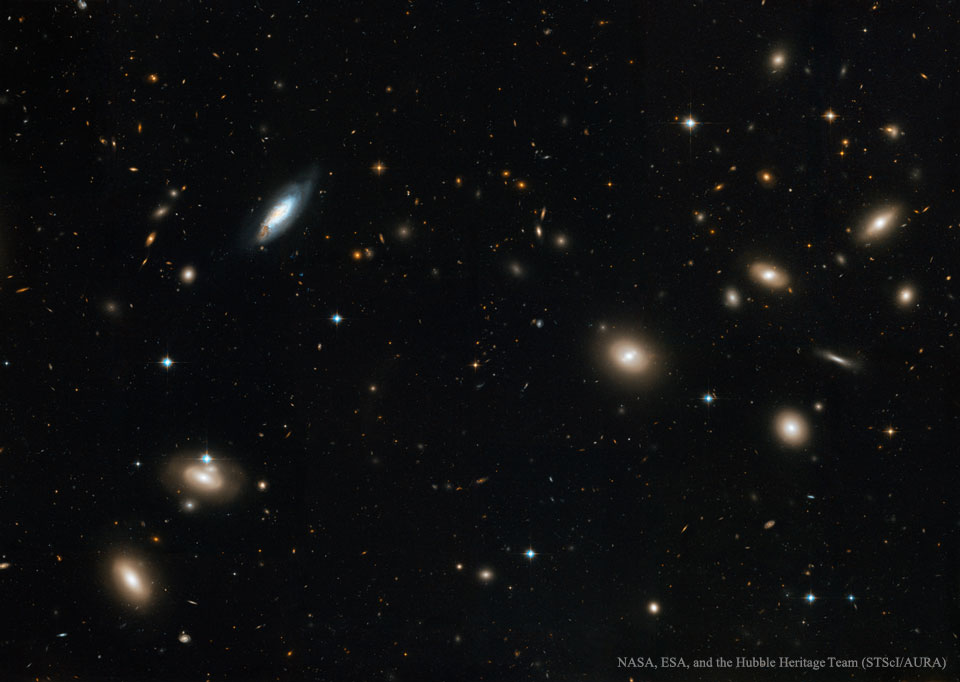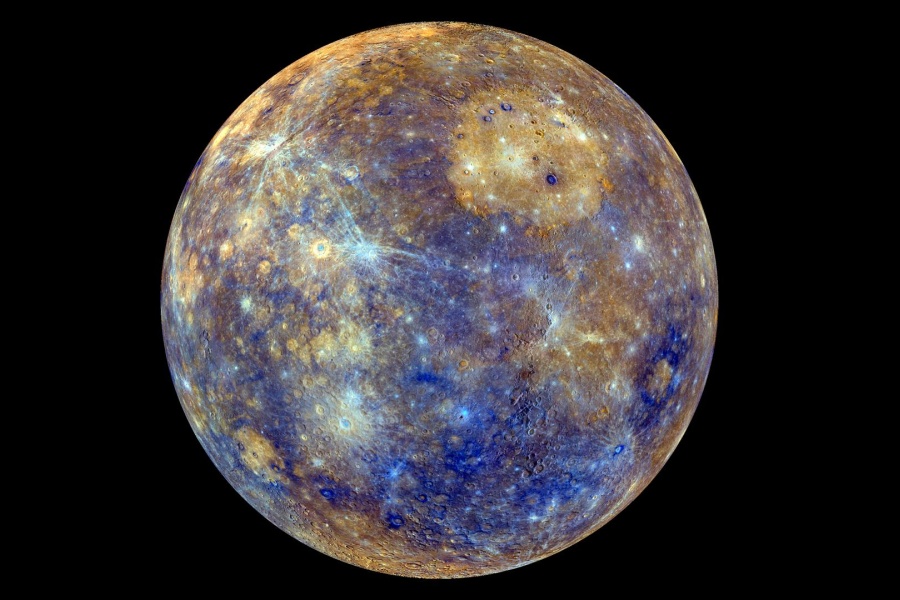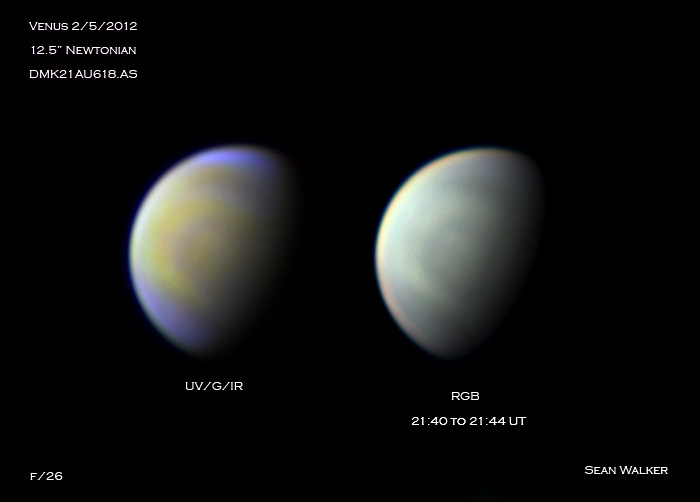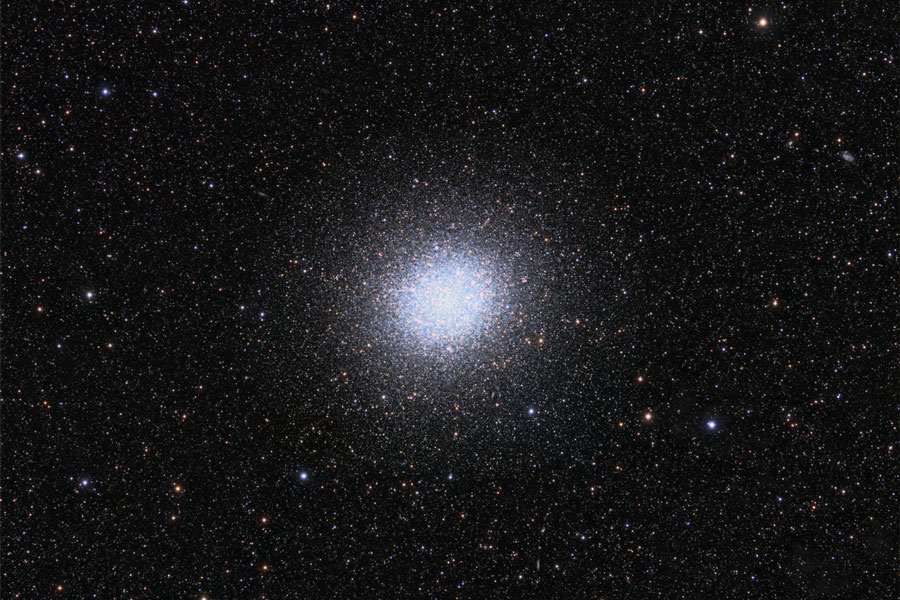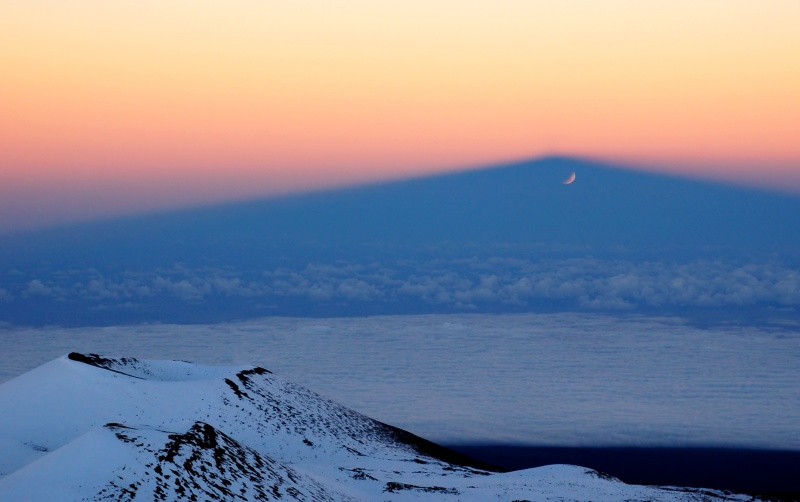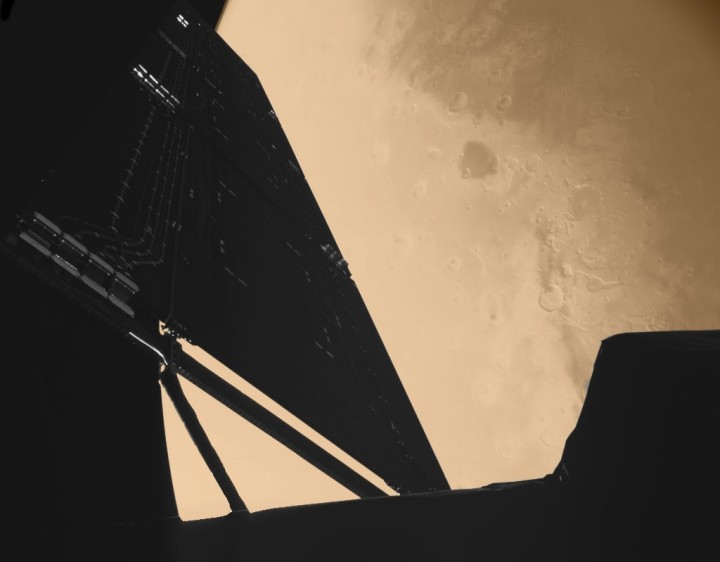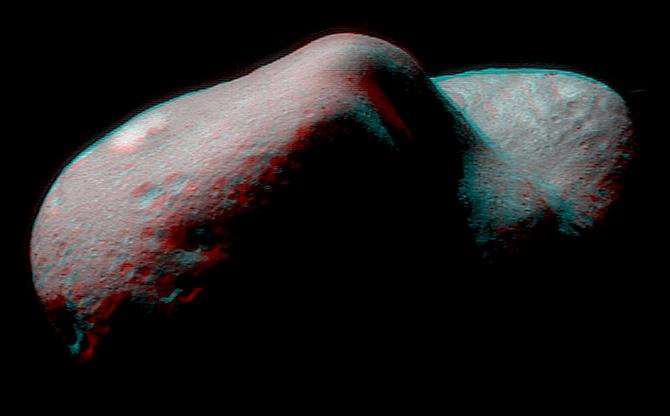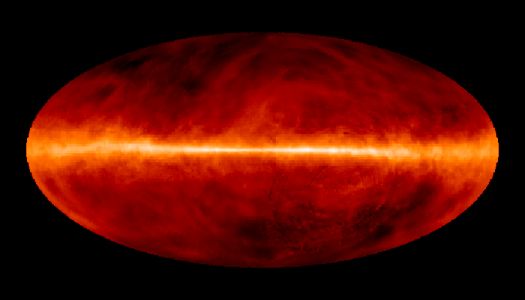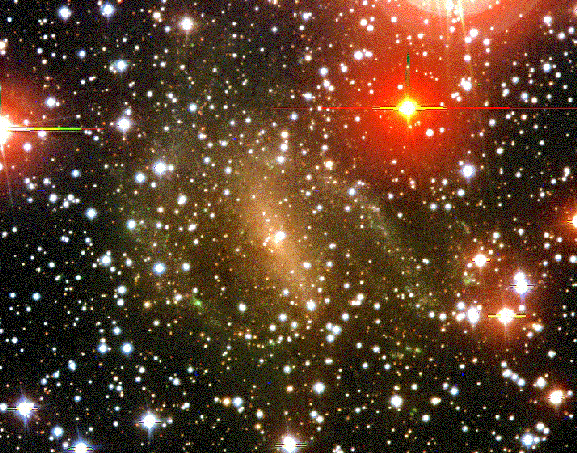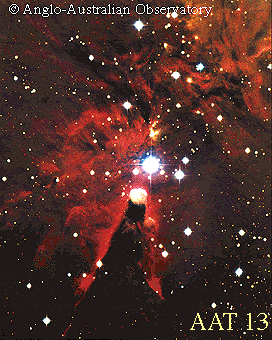| << Previous | Index | Next >> |
2015
2014 Big, beautiful spiral galaxy NGC 7331 is often touted as an analog to our own Milky Way. About 50 million light-years distant in the northern constellation Pegasus, NGC 7331 was recognized early on as a spiral nebula and is actually one of the brighter galaxies not included in Charles Messier's famous 18th century catalog. Since the galaxy's disk is inclined to our line-of-sight, long telescopic exposures often result in an image that evokes a strong sense of depth. The effect is further enhanced in this sharp image by galaxies that lie beyond the gorgeous island universe. The background galaxies are about one tenth the apparent size of NGC 7331 and so lie roughly ten times farther away. Their close alignment on the sky with NGC 7331 occurs just by chance. Seen here through faint foreground dust clouds lingering above the plane of Milky Way, this visual grouping of galaxies is also known as the Deer Lick Group.
2013 The colors of the solar system's innermost planet are enhanced in this tantalizing view, based on global image data from the Mercury-orbiting MESSENGER spacecraft. Human eyes would not discern the clear color differences but they are real none the less, indicating distinct chemical, mineralogical, and physical regions across the cratered surface. Notable at the upper right, Mercury's large, circular, tan colored feature known as the Caloris basin was created by an impacting comet or asteroid during the solar system's early years. The ancient basin was subsequently flooded with lava from volcanic activity, analogous to the formation of the lunar maria. Color contrasts also make the light blue and white young crater rays, material blasted out by recent impacts, easy to follow as they extend across a darker blue, low reflectance terrain.
2012 Brilliant Venus now shines in western skies at twilight. Seen as the prominent evening star, the planet is a tantalizing celestial beacon even for casual skygazers. Venus can offer less than satisfying telescopic views though. The planet is shrouded in reflective clouds that appear bright but featureless at the eyepiece. Still, careful imaging with a series of color filters, as used in these composite images, can reveal subtle cloud patterns. Captured early last month from a backyard observatory in Manchester, New Hampshire, USA, the images are based on video camera frames. The data was recorded through near-ultraviolet, green, and near-infrared filters (left), and red, green, and blue filters while Venus stood high above the western horizon just before sunset. This season's evening apparition of Venus is the best one for northern hemisphere observers in 7 years. It will ultimately end with a solar transit of the planet, the last one to occur in your lifetime, on June 5/6.
2011 What's happening outside the space station? A space shuttle has docked. Five days ago, the space shuttle Discovery was launched to the International Space Station, carrying six crew members and the large Leonardo Multi Purpose Logistics Module. Three days ago, as pictured above, the docked shuttle was prepared to be unloaded by the space stations Dextre robot and Canadarm2. The above expansive photo captures much more, however, including Japan's Kibo Experiment Module on the lower right, Earth across the top of the frame, and a seemingly starless backdrop of space in the distance. During the next week, the shuttle and ISS crews are scheduled to permanently attach Leonardo as well as fix and upgrade parts of the ISS. After 38 previous voyages, this is expected to be the last space mission for the Space Shuttle Discovery.
2010 What creates these picturesque dark streaks on Mars? No one knows for sure. A leading hypothesis is that streaks like these are caused by fine grained sand sliding down the banks of troughs and craters. Pictured above, dark sand appears to have flowed hundreds of meters down the slopes of Acheron Fossae. The sand appears to flow like a liquid around boulders, and, for some reason, lightens significantly over time. This sand flow process is one of several which can rapidly change the surface of Mars, with other processes including dust devils, dust storms, and the freezing and melting of areas of ice. The above image was taken by the HiRise camera on board the Mars Reconnaissance Orbiter which has been orbiting Mars since 2006. Acheron Fossae is a 700 kilometer long trough in the Diacria quadrangle of Mars.
2009 This huge ball of stars predates our Sun. Long before humankind evolved, before dinosaurs roamed, and even before our Earth existed, ancient globs of stars condensed and orbited a young Milky Way Galaxy. Of the 200 or so globular clusters that survive today, Omega Centauri is the largest, containing over ten million stars. Omega Centauri is also the brightest globular cluster, at apparent visual magnitude 3.9 it is visible to southern observers with the unaided eye. Cataloged as NGC 5139, Omega Centauri is about 18,000 light-years away and 150 light-years in diameter. Unlike many other globular clusters, the stars in Omega Centauri show several different ages and trace chemical abundances, indicating that the globular star cluster has a complex history over its 12 billion year age.
2008 Just opposite the setting Sun, the already-eclipsed Moon rose over the Hawaiian Islands on February 20. A view near the 14,000 foot peak of volcanic Mauna Kea on the Big Island, a popular spot for astronomers, offered this remarkable play of shadows and sunlight. With snowy cinder cones in the foreground, the Moon lies within the shadow cast by the mountain -- a shadow extending across a lower cloud deck and on through Earth's dense atmosphere. As the lunar eclipse is drawing to a close, the curved shadow of the limb of planet Earth itself can also be traced across the Moon's surface, some 400,000 kilometers away.
2007 Panels on ESA's Rosetta spacecraft appear in the foreground of this intriguing image of Mars recorded on February 25 at a range of about 1,000 kilometers. Launched in March 2004, Rosetta was near its closest approach to the Red Planet during a gravity assist flyby maneuver and is ultimately destined to rendezvous with a comet designated 67P/Churyumov-Gerasimenko. Below the comet-chasing spacecraft lies a dark boundary along the martian Syrtis region. But wait ... who took the picture? The picture was actually captured by the imaging system (CIVA) onboard Rosetta's lander, Philae, switched on for testing. The three-legged, box-shaped, 100 kilogram Philae is scheduled to attempt a landing on the comet nucleus after Rosetta's rendezvous in November 2014.
2006 Do nearly exact copies of you exist in other universes? If one or more of the multiverse hypotheses is correct, then quite possibly they do. In the above computer-enhanced illustration, independent universes are shown as independent circles or spheres. Spheres may be causally disconnected from all other spheres, meaning no communications can pass between them. Some spheres may contain different realizations of our universe, while others may have different physical laws. An entire set of parallel universes is called a multiverse. The human eye might represent the possibility that realizations of some multiverse hypotheses might only exist in the human mind. One criticism of multiverse hypotheses is that they are frequently difficult to test. Some multiverse hypotheses may therefore be great fun to think about but not practically falsifiable and therefore have no predictive scientific value.
2005 This dramatic image of an interacting pair of galaxies was made using 8-meter Gemini South telescope at Cerro Pachon, Chile. NGC 1531 is the background galaxy with a bright core just above center and NGC 1532 is the foreground spiral galaxy laced with dust lanes. The pair is about 55 million light-years away in the southern constellation Eridanus. These galaxies lie close enough together so that each feels the influence of the other's gravity. The gravitational tug-of-war has triggered star formation in the foreground spiral as evidenced by the young, bright blue star clusters along the upper edge of the front spiral arm. Though the spiral galaxy in this pair is viewed nearly edge-on, astronomers believe the system is similar to the face-on spiral and companion known as M51, the Whirlpool Galaxy.
2004 Are they gone? They were not originally predicted to even be there. The mystery revolves around strange shadow-like spokes that appeared on Saturn's large B-ring, the large middle ring in the complex system of particles that orbits Saturn. The spokes were discovered 23 years ago by the passing Voyager spacecraft and attributed to very fine dust of unknown origin. The missing spokes were noted in the above image, taken last month, from the robot Cassini spacecraft now approaching Saturn. Launched in 1997, the distance remaining between Cassini and Saturn is now less than half that between the Earth and the Sun. Cassini is expected to enter orbit around the ringed Jovian giant planet in July and drop a probe onto Titan, Saturn's largest moon.
2003 Get out your red/blue glasses and float next to asteroid 433 Eros, 170 million kilometers away! Orbiting the Sun once every 1.8 earth-years, asteroid Eros is a diminutive 40 x 14 x 14 kilometer world of undulating horizons, craters, boulders and valleys. Its unsettling scale and bizarre shape are emphasized in this picture - a mosaic of images from the NEAR Shoemaker spacecraft processed to yield a stereo anaglyphic view. Along with dramatic chiaroscuro, NEAR's 3-D imaging provided important measurements of the asteroid's landforms and structures, and clues to the origin of this city-sized chunk of solar system. The smallest features visible here are about 30 meters across. After spending a year in orbit around Eros, the historic Near Shoemaker spacecraft made the first ever landing on an asteroid's surface February 12, 2001.
2002 The Solar System's largest planet, gas giant Jupiter, is famous for its swirling Great Red Spot. In the right hand panel above, the familiar giant planet with storm system and cloud bands is shown in an optical image from the passing Cassini spacecraft. In the left hand panel, a false-color image from the orbiting Chandra Observatory presents a corresponding x-ray view of Jupiter. The Chandra image shows clearly, for the first time, x-ray spots and auroral x-ray emission from the poles. The x-ray spot dominating the emission from Jupiter's north pole (top) is perhaps as surprising for astronomers today as the Great Red Spot once was. Confounding previous theories, the x-ray spot is too far north to be associated with heavy electrically charged particles from the vicinity of volcanic moon Io. Chandra data also show that the spot's x-ray emission mysteriously pulsates over a period of about 45 minutes.
2001 Astronomers recently witnessed an astounding, large scale solar event as the Sun's north and south magnetic poles changed places! But, this complete solar magnetic field flip was actually anticipated. It occurs every 11 years during the maximum of the solar activity cycle. Plagues of sun spots, flaring active regions, and huge prominences are also hard-to-miss signs that the solar maximum is here. On February 12, the sungazing SOHO spacecraft captured this dramatic image of a magnificent prominence above the Sun's limb. Seen at the lower right, streams of relatively cool dense plasma were lofted along looping magnetic field lines extending outward about 30 times the diameter of planet Earth. Far above the limb at the upper right, a disconnected ghostly arc surrounds a dark cavity with bright central emission. These features are telltale signs of a coronal mass ejection -- yet another violent expulsion of material from the active Sun. Enormous, intensely bright active regions also mottle the solar surface in this image, recorded in the light of energetic Helium atoms by SOHO's Extreme ultraviolet Imaging Telescope.
2000 M13 is one of the most prominent and best known globular clusters. Visible with binoculars in the constellation of Hercules, M13 is frequently one of the first objects found by curious sky gazers seeking celestials wonders beyond normal human vision. M13 is a colossal home to over 100,000 stars, spans over 150 light years across, lies over 20,000 light years distant, and is over 12 billion years old. At the 1974 dedication of Arecibo Observatory, a radio message about Earth was sent in the direction of M13. The reason for the low abundance of unusual blue straggler stars in M13 is currently unknown.
1999 Reflection nebulae reflect light from a nearby star. Many small carbon grains in the nebula reflect the light. The blue color typical of reflection nebula is caused by blue light being more efficiently scattered by the carbon dust than red light. The brightness of the nebula is determined by the size and density of the reflecting grains, and by the color and brightness of the neighboring star(s). NGC 1435, pictured above, surrounds Merope (23 Tau), one of the brightest stars in the Pleiades (M45). The Pleiades nebulosity is caused by a chance encounter between an open cluster of stars and a molecular cloud. The unusual area on the far left, known as Bernard's Merope Nebula (IC 349), reflects visible light with unusually high efficiency.
1998 Interstellar space is filled with extremely tenuous clouds of gas which are mostly Hydrogen. The neutral hydrogen atom (HI in astronomer's shorthand) consists of 1 proton and 1 electron. The proton and electron spin like tops but can have only two orientations; spin axes parallel or anti-parallel. It is a rare event for Hydrogen atoms in the interstellar medium to switch from the parallel to the anti-parallel configuration, but when they do they emit radio waves with a wavelength of 21 centimeters (about 8 inches) and a corresponding frequency of exactly 1420 MHz. Tuned to this frequency radio telescopes have mapped the neutral Hydrogen in the sky. The above image represents such an all-sky HI survey with the plane of our Milky Way Galaxy running horizontally through the center. In this false color image no stars are visible, just diffuse clouds of gas tens to hundreds of light years across which cluster near the plane. The gas clouds seem to form arching, looping structures, stirred up by stellar activity in the galactic disk.
1997 Sometimes you can't see the forest for the trees. But if you look closely at the center of the above photograph, you will see a whole spiral galaxy behind the field of stars. Named Dwingeloo 1, this nearby galaxy was only discovered recently (1994) because much of its light was obscured by dust, gas and bright stars of our own Milky Way Galaxy. In fact, all the individually discernible stars in the above photograph are in our Galaxy. Dwingeloo 1 turned out to be a large galaxy located only five times as distant as the closest major galaxy - M31.
1996
| << Previous | Index | Next >> |
